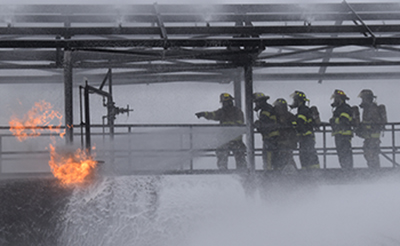Petrochemical companies are investing in training emergency responders who serve their communities
COLLEGE STATION – The petrochemical industry is investing in a new approach to help protect their facilities and the citizens who live nearby. Several petrochemical companies are partnering with the Texas A&M Engineering Extension Service (TEEX) to provide emergency response training to the communities surrounding their plants to protect the safety of local citizens.
Though incidents are rare at the nation’s petrochemical plants, when a fire occurs as it did at the Intercontinental Terminals Company in Deer Park earlier this year, the company and the community rely on Mutual Aid help from other nearby companies they have agreements with. However, when the plant in trouble is isolated with no other companies located close enough to help respond, they have to rely on local first responders to assist in extinguishing the blaze and protecting the community.
Some petrochemical plants are located in small or rural communities where the local volunteer fire department or municipal fire department may not have the funding to send their firefighters to the specialized training needed to fight these kinds of fires, said John Burge, who directs the industrial firefighting program at TEEX’s Emergency Services Training Institute (ESTI).

Valero, ExxonMobil Pipeline Co. and LyondellBasell are among the companies that have recently established training grants and partnered with TEEX to provide hands-on fire and hazardous materials training to firefighters from communities that surround their plants in the Houston area, across Texas and the Midwest. The training grants cover the costs for the firefighters to attend specialized training courses at the 296-acre Brayton Fire Training Field in College Station, Texas, which is one of the largest live-fire training facilities in the world.
The specialized TEEX course, “Industrial Emergencies for Municipal Based Responders,” or IEMBR, was requested by LyondellBasell for firefighters that serve communities around their facilities.
“Safety is embedded in our company culture and our staff often trains with local first responders to improve preparedness,” said Dale Friedrichs, LyondellBasell vice president, Health, Safety and Environment. “Texas A&M offers exceptional training which broadens the skills of firefighters. We understand the funding challenges that some municipalities face, and we’re honored to support those who put their lives on the line every day.”

“Funding from Valero allowed us to train approximately 60 firefighters from across the Midwest in the proper techniques for extinguishing ethanol fires,” Burge said. “These firefighters from communities surrounding Valero plants will take those skills back home and share their new knowledge with fellow firefighters where they will be better prepared to respond to emergencies and help protect their community and the Valero assets. This is good for both the community and the facility.”
The firefighters who come to Brayton Fire Training Field for training get hands-on experience fighting actual fires on large, full-scale props simulating industrial plants, storage tanks, pipe racks, process units, rail car loading terminals, hazmat chemical leaks and crude by rail fires. “Lectures only go so far,” Burge says. “Until they actually fight these fires, the lessons can be difficult to learn; but once they ‘look the devil in the eyes,’ they won’t forget.”
For ExxonMobil, TEEX is providing 16 hours of training for up to 150 firefighters in HazMat liquid pipeline and industrial fire emergencies.
“As a company that prioritizes safety, ExxonMobil is proud to partner with TEEX to create a program specifically focused on training firefighters to safely manage oil pipeline and tank emergencies,” said Johnita Jones, Vice President – Southern Operations Manager, ExxonMobil Pipeline Company. “While such incidents are infrequent, our goal is to make sure these firefighters and other first responders – many of whom are volunteers and the first line of defense in protecting our communities and the environment – are prepared and equipped to safely manage these types of emergencies.”
The investment in training is a win-win for the companies and for the communities, Burge says. “They are investing money in the communities to train the firefighters in the local fire departments, which could save lives as well as save the plant and the jobs that support the local economy. At TEEX, we are extremely pleased to partner with these companies that are stepping up to the plate to make sure that our volunteer and municipal responders are getting the specialized training needed to be an asset during an industrial emergency.”
For more information, contact:
Casey Richardson
Texas A&M Engineering Extension Service
9794582819
